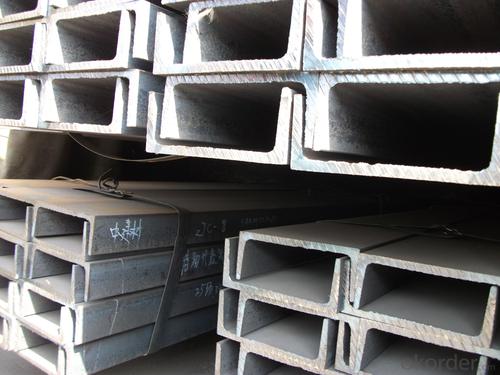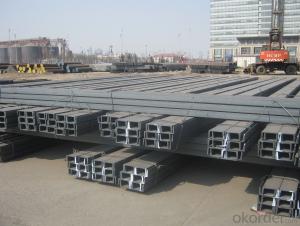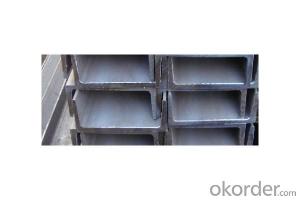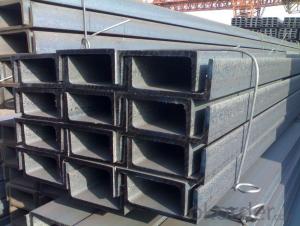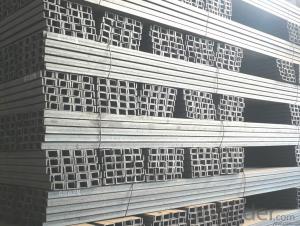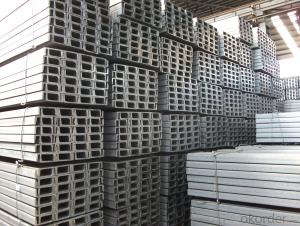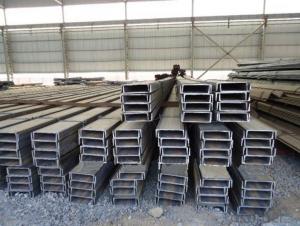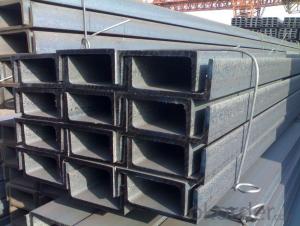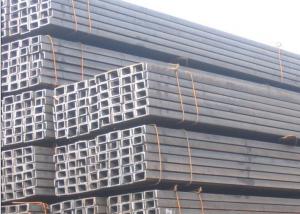hot rolled steel channel
- Loading Port:
- Tianjin
- Payment Terms:
- TT OR LC
- Min Order Qty:
- 3000 m.t.
- Supply Capability:
- 35000 m.t./month
OKorder Service Pledge
OKorder Financial Service
You Might Also Like
Product Description:
Steel U Channel Details:
Minimum Order Quantity: 25 Tons Unit: m.t. Loading Port: Xingang Port
Supply Ability: 1000 Tons Per Day Payment Terms: TT or L/C
Product Description:
Specifications of Steel U Channel:
Standard Applied: GB Standard, EN Standard(UPN), JIS Standard
Sizes: 50mm to 300mm
Material Grade: Q235B, Q345B, S235JR, SS400, ASTM A36
As shown in the figure:
Usage/Application of Steel U Channel:
The steel u channel can be applied to construction of warehouses, workshops, sport stadiums and car parks etc. In details, the steel u channel belongs to carbon structural steel which is applied to in the field of construction and machinery. The steel u channel is usually used for arch-itechtural structure, and they could be welded in order to support or hang a vari-ety of facilities. They are also usually used in combination with I beam. Generally,the steel u channel must possess perfect welding property, riveting property and mechanical property and so on.
Package & Delivery: Steel U Channel
The steel u channel will be packed in bundle with steel wire at each end of every bundle and color marking in order to help the customer to recognize his goods more easily at sight.
And steel u channel could be loaded into 20ft or 40ft container, or by bulk cargo. If the weight of each bundle reaches less than 3.5 mt, the loading by break bulk cargo should be choosed. When the weight of each bundle reaches less than 3mt, the loading by container should be choosed.
As for the transportaion from mill to loading port, the truck will be usually used. And the maximum quantity for each truck is 40mt.
All in all, we could do in accordance with customer's request
- Q: How are steel channels protected during transportation and storage?
- Steel channels are typically protected during transportation and storage through various measures. These include using appropriate packaging materials such as wooden crates or pallets to prevent physical damage and corrosion. Additionally, protective coatings or films are often applied to the steel channels to safeguard against moisture and rust. Proper handling and storing techniques, such as keeping them away from direct sunlight and extreme weather conditions, also play a crucial role in ensuring their protection.
- Q: How do steel channels perform under heavy loads?
- Steel channels are renowned for their exceptional strength and durability, which enables them to effectively handle heavy loads. Their structural design allows for the even distribution and transfer of weight, thereby preventing the formation of concentrated stress points that may lead to failure. Furthermore, steel channels possess a remarkable load-bearing capacity as they possess the ability to resist bending and twisting forces. This quality renders them ideal for providing support to heavy machinery, equipment, and structures, thereby ensuring stability and safety. Additionally, steel channels exhibit superior resistance to compression and tension forces, making them suitable for a wide range of applications across various industries. In summary, steel channels excel in their ability to handle heavy loads by providing reliable support, stability, and load-bearing capabilities.
- Q: What are the different methods of fastening steel channels?
- Depending on the specific application and requirements, there are various methods available for fastening steel channels. Some commonly used methods include: 1. The traditional and widely used method involves using bolts and nuts. In this method, bolts are inserted through pre-drilled holes in the channel and secured with nuts on the opposite side, ensuring a strong and secure connection. 2. Welding is a commonly used method for fastening steel channels, particularly in permanent and structurally critical applications. This method involves heating and fusing the steel channel to another steel component or structure, resulting in a strong and seamless connection. 3. Rivets can also be used to fasten steel channels. This method involves inserting a rivet through pre-drilled holes and securing it by deforming the end of the rivet. It is often used in applications requiring high shear strength. 4. Adhesive bonding offers the advantage of a clean and aesthetically pleasing appearance. High-strength adhesives or epoxy resins are used to bond steel channels together, eliminating the need for visible fasteners. 5. Clamps provide a tight grip around the steel channel, securing it to another component or structure. This method is commonly used for temporary or adjustable connections. 6. Self-tapping screws are another option for fastening steel channels to other steel components. These screws have a pre-formed thread that allows them to cut into the steel as they are screwed in, providing a secure connection without the need for pre-drilled holes. 7. Brackets and clips are often used to fasten steel channels to walls, ceilings, or other structures. These accessories offer a secure and adjustable connection, facilitating easy installation and adjustment if required. When selecting the most suitable method for fastening steel channels, it is crucial to consider the specific requirements of the application, including load capacity, aesthetics, and accessibility.
- Q: What are the factors that affect the cost of steel channels?
- The cost of steel channels can be affected by several factors. Firstly, the cost of raw materials plays a significant role. Factors like supply and demand, production costs, and global economic conditions can directly impact the price of steel, thus affecting the cost of steel channels. Another factor that influences the cost is the size and specifications of the channels. Larger or more specialized channels may require additional processing or customization, leading to increased costs. The complexity of the design or the need for specific coatings or finishes can also impact the final price. The manufacturing process itself contributes to determining the cost. Different production methods, such as hot-rolling or cold-forming, have varying associated costs. Additionally, the location of the steel production facility and transportation costs can affect the overall price. Market conditions and competition also have a role in determining the cost of steel channels. When demand is high and supply is limited, prices tend to rise. Conversely, during periods of low demand or increased competition, prices may decrease. Lastly, any additional services or value-added features, like cutting, drilling, or welding, can increase the cost of steel channels. These services require additional labor, equipment, and expertise, resulting in an overall higher price. In conclusion, the cost of steel channels is influenced by various factors, including raw material prices, size and specifications, manufacturing process, market conditions, competition, and additional services. It is crucial for businesses and consumers to understand these factors in order to make informed decisions when purchasing steel channels.
- Q: How do steel channels contribute to the ease of construction?
- Steel channels contribute to the ease of construction by providing structural support and stability. They are commonly used as beams or columns in building construction to distribute the weight of the structure and resist lateral forces. The use of steel channels allows for efficient and cost-effective construction, as they can be easily fabricated, transported, and assembled on-site. Additionally, their high strength-to-weight ratio and durability make them ideal for withstanding heavy loads and ensuring the longevity of the building.
- Q: Are steel channels suitable for high-temperature manufacturing processes?
- High-temperature manufacturing processes generally find steel channels to be suitable. Steel possesses exceptional heat resistance and can endure high temperatures without significant deformation or structural damage. Furthermore, steel channels often serve in applications where temperature fluctuations occur frequently, thus establishing them as a dependable choice for high-temperature manufacturing processes. However, when determining the appropriateness of steel for high-temperature manufacturing processes, it is crucial to consider the specific type of steel used and its composition. Different steel alloys possess varying melting points and heat resistance properties. For exceedingly high-temperature applications, specialized alloys like stainless steel or heat-resistant alloys such as Inconel are commonly preferred. Moreover, it is vital to consider the specific requirements of the manufacturing process. Factors such as the duration of exposure to high temperatures, the presence of corrosive substances, and the need for thermal expansion must be taken into account. Seeking advice from a materials engineer or a steel supplier with expertise in high-temperature applications can ensure the selection of the most suitable steel channel for specific manufacturing processes.
- Q: Are steel channels suitable for overhead crane systems?
- Yes, steel channels are suitable for overhead crane systems. Steel channels provide excellent strength and durability, making them ideal for supporting heavy loads and withstanding the stress and strain of crane operations. Additionally, steel channels can be easily fabricated and installed, allowing for efficient construction of overhead crane systems.
- Q: What are the advantages of using steel channels over other materials?
- Using steel channels instead of other materials offers several advantages: 1. High strength and durability: Steel channels are renowned for their ability to bear heavy loads and provide structural stability. This makes them suitable for a wide range of construction and engineering applications. 2. Versatility: Steel channels can be easily shaped and manipulated to meet specific requirements. Whether they need to be cut, welded, or bent, they offer flexibility in design and construction projects. 3. Cost-effective: Compared to materials like aluminum or wood, steel channels are a cost-effective choice. They require minimal maintenance, have a longer lifespan, and can be recycled, resulting in reduced overall construction and maintenance costs. 4. Fire-resistant: Steel channels inherently possess fire resistance properties, making them a safer option for building structures. They do not contribute to the spread of fire and allow for more time during emergencies for people to evacuate. 5. Sustainability: Steel is highly sustainable as it can be recycled endlessly without losing its properties. Opting for steel channels promotes environmental conservation and reduces the carbon footprint associated with construction projects. 6. Corrosion resistance: Steel channels can be treated with coatings or galvanized to enhance their resistance to corrosion. This makes them suitable for outdoor applications where they may come into contact with moisture, humidity, or other corrosive elements. 7. Structural integrity: Steel channels provide excellent structural integrity, ensuring that the components they support remain stable and secure. This is especially important in applications where safety and load-bearing capacity are crucial, such as bridges, high-rise buildings, or industrial structures. In conclusion, the use of steel channels offers numerous advantages including strength, durability, versatility, cost-effectiveness, fire resistance, sustainability, resistance to corrosion, and maintenance of structural integrity. These benefits make steel channels the preferred choice for various construction and engineering projects.
- Q: What are the common design codes and standards for steel channels?
- There are several common design codes and standards for steel channels that ensure their structural integrity and safety. The most widely recognized codes and standards for steel channel design are: 1. American Institute of Steel Construction (AISC): AISC provides the specification for the design, fabrication, and erection of structural steel for buildings, also known as the AISC Steel Construction Manual. This manual outlines guidelines for the design of steel channels, including their dimensions, loading conditions, and connection requirements. 2. American Society of Civil Engineers (ASCE): ASCE produces standards and guidelines for various civil engineering structures, including steel channels. Their publication, ASCE 7-16 Minimum Design Loads and Associated Criteria for Buildings and Other Structures, provides specifications for determining the loads and load combinations that steel channels must be designed to withstand. 3. International Building Code (IBC): The IBC is a comprehensive set of building regulations adopted by many countries globally. It includes provisions for the design of steel channels and other structural elements, focusing on safety, load resistance, and structural stability. 4. European Committee for Standardization (EN): The EN standards provide specifications for various steel products, including channels. EN 10025-2 is specifically applicable to hot-rolled structural steel channels and outlines their mechanical properties, dimensions, and tolerances. 5. British Standards Institution (BSI): BSI publishes standards for steel channels under the BS EN 10365 series. These standards cover the dimensions, tolerances, and technical requirements for hot-rolled steel channels used in construction. It is important for designers, engineers, and manufacturers to adhere to these codes and standards to ensure the proper design, fabrication, and safe usage of steel channels in various structural applications. Compliance with these guidelines helps ensure consistency, quality, and structural integrity in the construction industry.
- Q: What are the different types of bracing systems used with steel channels?
- There are several different types of bracing systems that can be used with steel channels, depending on the specific requirements and structural needs of a project. Some of these bracing systems include: 1. Cross bracing: This is the most common type of bracing used with steel channels. It involves placing diagonal members or cables between two or more steel channels in a crisscross pattern. Cross bracing helps to evenly distribute the load and provides stability to the structure. 2. K-bracing: This bracing system consists of diagonal members or cables that form a K-shape between steel channels. It is typically used in buildings with rectangular or square footprints, as it provides strong resistance to lateral forces. 3. Chevron bracing: Similar to K-bracing, chevron bracing also utilizes diagonal members or cables. However, in this system, the diagonal members form a V-shape or chevron pattern. Chevron bracing is often used in structures where space is limited, as it requires less material and allows for more open floor plans. 4. X-bracing: This bracing system involves placing diagonal members or cables in an X-shape between steel channels. It is commonly used in buildings with long spans or high wind loads, as it provides excellent resistance to lateral forces. 5. Portal bracing: Portal bracing is used in buildings with large openings, such as garages or warehouses. It involves adding diagonal members or cables to create a portal frame between steel channels. This type of bracing helps to distribute the load evenly and prevents deformation of the structure. 6. Eccentric bracing: Eccentric bracing is a specialized bracing system that allows for controlled yielding during seismic events. It involves placing diagonal members or cables off-center from the vertical axis of the steel channels, which helps to dissipate energy and reduces the impact of seismic forces. These are just a few examples of the different types of bracing systems that can be used with steel channels. The choice of bracing system will depend on factors such as the structural requirements, building codes, and the specific needs of the project.
Send your message to us
hot rolled steel channel
- Loading Port:
- Tianjin
- Payment Terms:
- TT OR LC
- Min Order Qty:
- 3000 m.t.
- Supply Capability:
- 35000 m.t./month
OKorder Service Pledge
OKorder Financial Service
Similar products
Hot products
Hot Searches
Related keywords




